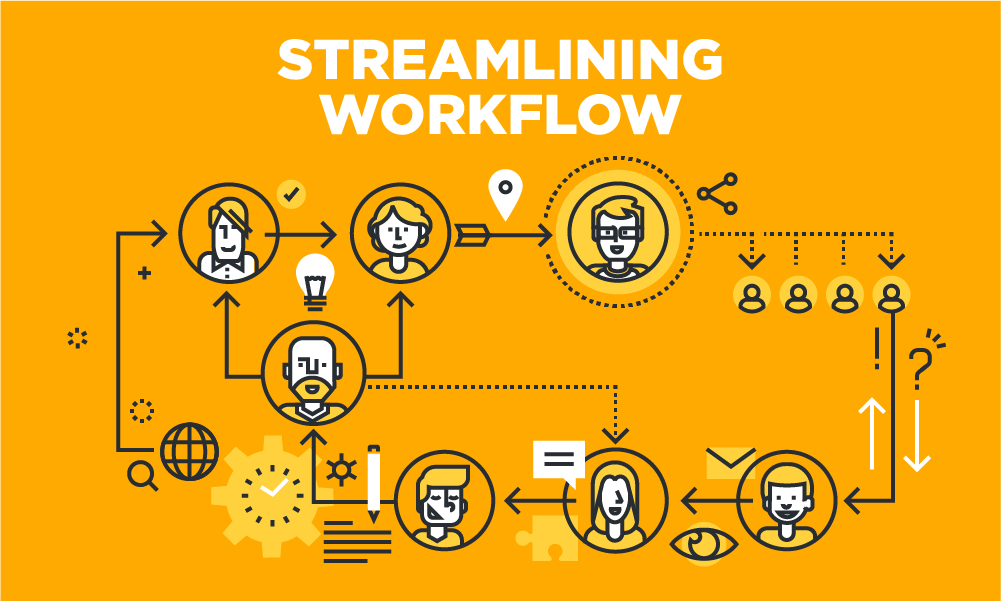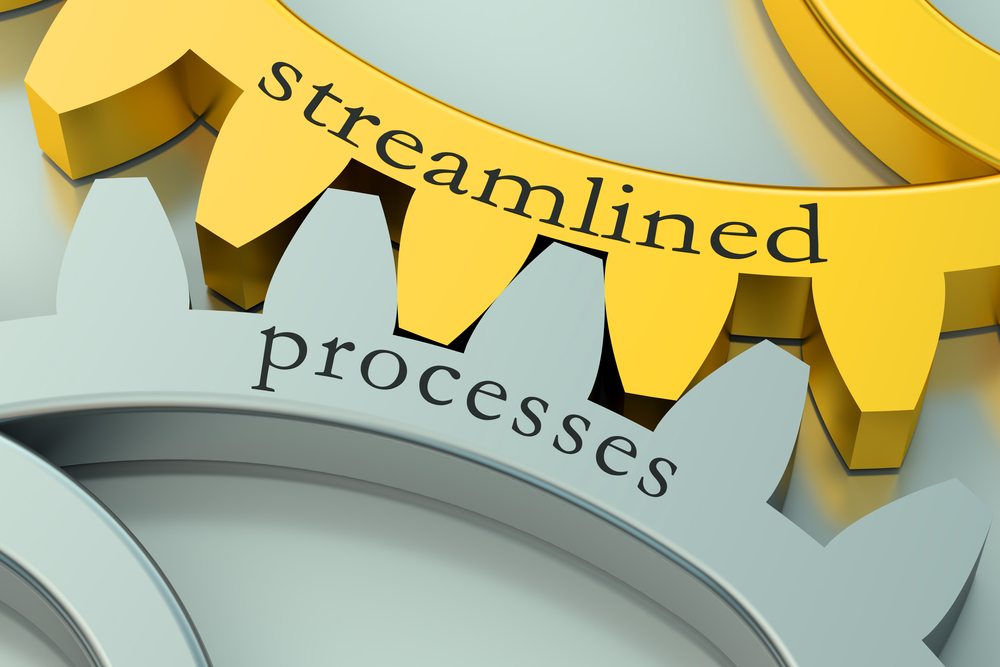How To Streamline Your Workflow: A Step-by-Step Guide To Efficiency
Streamlining Your Workflow: A Step-by-Step Approach refers to a systematic process of optimizing and simplifying existing workflows to enhance efficiency, productivity, and overall performance. For instance, a customer service team may streamline its workflow by implementing a centralized ticketing system that automates task assignment and prioritization, reducing response times and improving customer satisfaction.
Streamlining workflows has become increasingly important in today's fast-paced business environment, where organizations strive to maximize profitability and minimize operational costs. Benefits include increased productivity, reduced errors, improved communication, and enhanced customer satisfaction. A key historical development in workflow streamlining was the emergence of Lean Manufacturing principles in the mid-20th century, which emphasized the elimination of waste and the optimization of production processes.
This article will provide a comprehensive step-by-step guide to streamlining your workflow, covering essential aspects such as process mapping, task automation, performance monitoring, and continuous improvement. By following the outlined steps, organizations can significantly enhance their operational efficiency and achieve their business objectives.
Streamline Your Workflow A Step By Step
Effective workflow streamlining encompasses multiple essential aspects, each playing a critical role in optimizing business processes and enhancing overall performance. These key aspects provide a comprehensive framework for organizations to analyze, improve, and continuously refine their workflows.
- Process Mapping
- Task Automation
- Performance Monitoring
- Continuous Improvement
- Communication
- Collaboration
- Technology
- Leadership
- Culture
Process mapping, task automation, and performance monitoring form the foundation of workflow streamlining, providing organizations with a clear understanding of their existing processes, the potential for automation, and the effectiveness of their operations. Continuous improvement, communication, and collaboration are essential for fostering a culture of innovation and ongoing optimization. Technology, leadership, and culture play significant roles in supporting and sustaining streamlining efforts, ensuring that organizations have the necessary tools, guidance, and mindset to achieve their goals.
Process Mapping
Process mapping is a fundamental aspect of workflow streamlining, providing a structured approach to analyze, document, and optimize existing processes. By visually representing each step, decision point, and stakeholder involved, process mapping helps organizations identify inefficiencies, redundancies, and potential areas for improvement.
- Process Decomposition
Breaking down complex processes into smaller, manageable components allows for a more detailed analysis and identification of specific pain points or bottlenecks.
- Flowcharting
Using flowcharts to visually represent the sequence of steps, decisions, and outcomes provides a clear and concise overview of the process, facilitating communication and understanding among stakeholders.
- Data Collection
Gathering data on process performance, such as cycle times, errors, and customer feedback, helps organizations quantify the impact of streamlining efforts and make data-driven decisions.
- Process Simulation
Simulating processes using software tools allows organizations to test different streamlining scenarios and evaluate their potential impact before implementing changes in the real world.
Process mapping provides a comprehensive understanding of how work is currently being done, enabling organizations to identify opportunities for automation, eliminate unnecessary steps, and improve overall efficiency. It also serves as a foundation for continuous improvement initiatives, allowing organizations to track progress, measure the effectiveness of changes, and make further refinements over time. By investing in effective process mapping, organizations can gain a competitive advantage and achieve significant improvements in productivity, customer satisfaction, and operational costs.
Task Automation
Task automation plays a pivotal role in streamlining workflows, enabling organizations to optimize processes, reduce manual labor, and enhance productivity. It involves leveraging technology to perform repetitive or rule-based tasks, freeing up human resources to focus on more strategic and value-added activities.
- Process Identification
The first step involves identifying tasks that are suitable for automation, considering factors such as frequency, complexity, and potential impact on efficiency.
- Technology Selection
Choosing the appropriate automation technology is crucial, considering factors such as cost, scalability, ease of use, and integration with existing systems.
- Implementation and Monitoring
Effective task automation requires careful implementation and ongoing monitoring to ensure smooth operation, accuracy, and alignment with business objectives.
- Continuous Improvement
Automation should be viewed as an ongoing journey, with regular reviews and refinements to optimize performance and adapt to changing business needs.
By embracing task automation as part of a comprehensive workflow streamlining strategy, organizations can unlock significant benefits, including reduced operating costs, improved accuracy and consistency, increased productivity, enhanced employee satisfaction, and a competitive edge in the marketplace.
Performance Monitoring
Performance monitoring is an essential component of streamlining your workflow as it provides critical insights into the effectiveness and efficiency of your processes. By tracking key metrics and analyzing performance data, organizations can identify bottlenecks, inefficiencies, and areas for improvement. This data-driven approach allows for targeted interventions and adjustments to optimize workflows, leading to increased productivity, cost savings, and improved customer satisfaction.
Real-life examples of performance monitoring in workflow streamlining include:
- Tracking cycle times to identify and reduce delays in approval processes.
- Monitoring error rates to pinpoint areas where automation or training can improve accuracy.
- Measuring customer satisfaction to gauge the impact of workflow changes on the end-user experience.
Understanding the connection between performance monitoring and workflow streamlining is crucial for organizations seeking to continuously improve their operations. By leveraging performance data to identify and address inefficiencies, organizations can make informed decisions that result in a leaner, more efficient, and more effective workflow.
Continuous Improvement
Continuous improvement is a fundamental principle in the context of workflow streamlining. It involves the ongoing process of analyzing, evaluating, and refining workflows to enhance efficiency, productivity, and overall performance. This iterative approach is crucial for organizations seeking to remain competitive and adaptable in a rapidly changing business landscape.
Continuous improvement is an integral component of workflow streamlining, as it enables organizations to identify and address inefficiencies, eliminate bottlenecks, and optimize processes on a regular basis. By fostering a culture of continuous improvement, organizations can ensure that their workflows remain lean, effective, and aligned with evolving business objectives.
Real-life examples of continuous improvement in workflow streamlining include:
Regularly reviewing and updating process maps to identify and eliminate redundancies or inefficiencies. Continuously monitoring performance metrics to track progress, identify areas for improvement, and make data-driven adjustments. Encouraging employee feedback and suggestions to gather insights and identify potential improvements in existing workflows.Understanding the connection between continuous improvement and workflow streamlining is essential for organizations seeking to achieve operational excellence. By embracing a mindset of continuous improvement, organizations can unlock significant benefits, including reduced costs, increased productivity, enhanced customer satisfaction, and a competitive advantage in the marketplace.
Communication
Effective communication is a critical component of streamlining your workflow. It enables seamless information exchange, coordination, and collaboration among individuals and teams, contributing significantly to the overall efficiency and effectiveness of workflow processes.
Clear and timely communication ensures that everyone involved in a workflow has the necessary information to perform their tasks accurately and efficiently. It eliminates misunderstandings, reduces delays, and fosters a sense of shared purpose and accountability. By establishing open channels of communication, organizations can break down silos, promote transparency, and facilitate knowledge sharing, leading to better decision-making and problem-solving.
Real-life examples of effective communication in workflow streamlining include:
Regular team meetings to discuss progress, identify challenges, and make necessary adjustments. Centralized communication platforms that provide a single source of truth for all project-related information. Clear documentation and instructions that guide individuals through complex tasks.Understanding the connection between communication and workflow streamlining is essential for organizations seeking to optimize their operations. By fostering a culture of effective communication, organizations can create a collaborative and efficient work environment that drives productivity, innovation, and customer satisfaction.
Collaboration
Collaboration is a cornerstone of streamlined workflows. It fosters teamwork, knowledge sharing, and collective problem-solving, leading to increased efficiency and productivity. Collaboration can encompass various dimensions, including:
- Shared Goals and Objectives
Aligning team members on common goals creates a sense of purpose and shared responsibility, promoting collaboration and fostering a collaborative mindset.
- Effective Communication
Open and transparent communication channels facilitate information sharing, reduce misunderstandings, and enable team members to stay informed and coordinated.
- Cross-Functional Teams
Breaking down silos and encouraging collaboration between different departments or teams brings diverse perspectives and expertise, leading to innovative solutions and improved workflows.
- Technology Tools
Utilizing collaboration software, such as project management platforms or instant messaging tools, can enhance communication, streamline task assignment, and foster virtual collaboration.
By fostering a collaborative work environment, organizations can enhance knowledge sharing, promote innovation, and create a sense of collective ownership, resulting in streamlined workflows and improved overall performance.
Technology
Technology plays a pivotal role in streamlining workflows, empowering organizations to automate tasks, enhance communication and collaboration, and gain valuable insights into their processes. Its integration is driven by the need for efficiency, accuracy, and continuous improvement, making it a critical component of modern workflow streamlining strategies.
Real-life examples of technology's impact on workflow streamlining include:
Robotic Process Automation (RPA)RPA bots can automate repetitive, rule-based tasks, freeing up human workers for more complex and strategic responsibilities.
Workflow Management SystemsThese systems provide a centralized platform for managing and tracking workflows, ensuring seamless collaboration and task coordination.
Data Analytics ToolsBy analyzing workflow data, organizations can identify bottlenecks, optimize resource allocation, and make data-driven decisions to improve efficiency.
Understanding the practical significance of this connection empowers organizations to leverage technology strategically. By investing in the right tools and technologies, they can streamline workflows, boost productivity, reduce costs, and gain a competitive edge in the digital age. However, it's important to note that technology alone is not a silver bullet; successful workflow streamlining requires a comprehensive approach that considers process optimization, cultural change, and ongoing improvement efforts.
Leadership
Within the context of streamlining workflows, leadership plays a pivotal role in setting the direction, fostering collaboration, and driving continuous improvement. Effective leadership creates an environment conducive to streamlining efforts, where individuals are empowered to contribute and innovate, while the organization remains focused on its overarching goals.
- Visionary Direction
Leaders articulate a clear vision and purpose for workflow streamlining, inspiring teams to embrace change and work towards a common objective. They communicate the "why" behind streamlining efforts, ensuring that everyone understands the value and benefits of the initiative.
- Empowering Teams
Effective leaders empower their teams by providing autonomy, resources, and support. They create a culture of trust and accountability, where individuals feel comfortable taking ownership of their tasks and contributing their ideas. Empowered teams are more likely to be engaged and innovative in their approach to workflow streamlining.
- Fostering Collaboration
Leaders foster collaboration by breaking down silos and encouraging cross-functional teamwork. They create opportunities for individuals from different departments or teams to share knowledge, perspectives, and expertise. This collaborative environment enhances problem-solving and leads to more effective and efficient workflows.
- Continuous Improvement Mindset
Leaders instill a mindset of continuous improvement throughout the organization. They create a culture where feedback is valued, and individuals are encouraged to identify areas for process optimization. This mindset drives ongoing efforts to streamline workflows, leading to sustained improvements in efficiency and productivity.
In conclusion, leadership is a multifaceted aspect of streamlining your workflow. By providing visionary direction, empowering teams, fostering collaboration, and instilling a continuous improvement mindset, leaders create an environment where individuals and teams can thrive. This, in turn, leads to streamlined workflows, increased efficiency, and improved overall organizational performance.
Culture
Within the context of "Streamline Your Workflow A Step By Step," "Culture" encompasses the shared values, beliefs, and behaviors that shape how individuals and teams approach and execute their work. It plays a crucial role in determining the success of workflow streamlining efforts by influencing how employees collaborate, communicate, and adapt to change.
- Openness to Change
A culture that embraces change encourages individuals to question existing processes, experiment with new ideas, and adapt to evolving business needs. This openness is essential for successful workflow streamlining, as it allows teams to identify and eliminate inefficiencies and embrace innovative solutions.
- Collaboration and Teamwork
A collaborative culture fosters teamwork, knowledge sharing, and open communication among individuals and teams. This collaborative environment is crucial for streamlining workflows, as it enables teams to combine their expertise, perspectives, and experiences to develop and implement effective solutions.
- Continuous Improvement Mindset
A culture of continuous improvement encourages individuals and teams to continuously seek ways to improve existing processes and workflows. This mindset drives ongoing efforts to identify and eliminate bottlenecks, reduce waste, and enhance efficiency, leading to sustained improvements in performance.
- Empowerment and Ownership
A culture that empowers individuals and teams gives them the authority and responsibility to make decisions and take ownership of their work. This empowerment is essential for successful workflow streamlining, as it allows individuals to take initiative, experiment with new ideas, and contribute to the overall success of the effort.
In conclusion, "Culture" plays a multifaceted role in "Streamline Your Workflow A Step By Step." By fostering openness to change, collaboration and teamwork, a continuous improvement mindset, and empowerment and ownership, organizations can create a culture that supports and drives successful workflow streamlining efforts. This, in turn, leads to increased efficiency, productivity, and overall organizational performance.
In conclusion, "Streamline Your Workflow A Step By Step" delves into the intricacies of optimizing and simplifying workflows to enhance efficiency, productivity, and overall performance. By systematically examining essential aspects such as process mapping, task automation, performance monitoring, and continuous improvement, organizations can gain valuable insights into their existing workflows and identify areas for optimization. The article emphasizes the interconnectedness of these elements, highlighting the need for a comprehensive approach that considers both technical and cultural factors.
Two key takeaways from this exploration include the importance of fostering a culture of continuous improvement and empowering individuals and teams. A continuous improvement mindset drives ongoing efforts to identify and eliminate inefficiencies, leading to sustained improvements in performance. Empowering individuals and teams, on the other hand, allows them to take ownership of their work, experiment with new ideas, and contribute to the overall success of workflow streamlining efforts. By embracing these principles, organizations can create a dynamic and adaptable work environment that is conducive to streamlined workflows and improved performance.

Streamlining Recruitment Process

4 Ways to Streamline Your Tasks

How to Streamline Your Marketing Workflow DivvyHQ